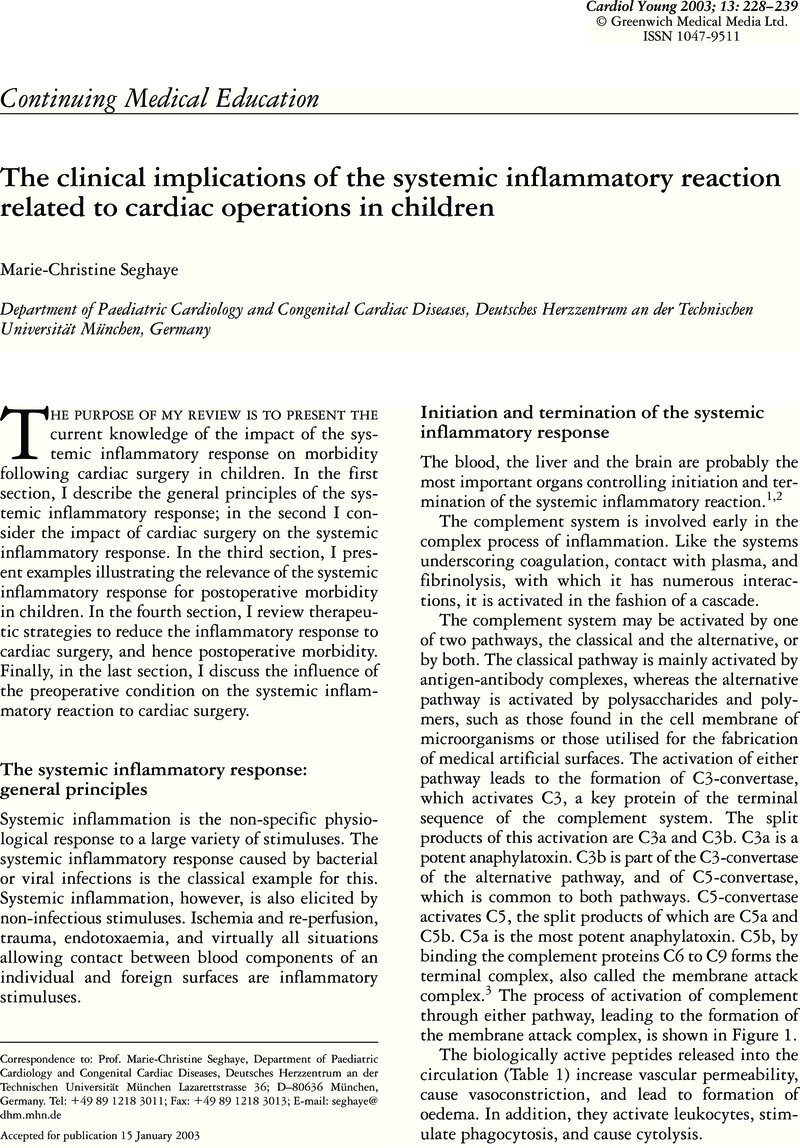Crossref Citations
This article has been cited by the following publications. This list is generated based on data provided by Crossref.
Raja, Shahzad G
and
Dreyfus, Gilles D
2005.
Modulation of Systemic Inflammatory Response after Cardiac Surgery.
Asian Cardiovascular and Thoracic Annals,
Vol. 13,
Issue. 4,
p.
382.
Draaisma, Anjo M.
and
Hazekamp, Mark G.
2005.
Coated versus Noncoated Circuits in Pediatric Cardiopulmonary Bypass.
ASAIO Journal,
Vol. 51,
Issue. 5,
p.
663.
Kozik, Deborah J.
and
Tweddell, James S.
2006.
Characterizing the Inflammatory Response to Cardiopulmonary Bypass in Children.
The Annals of Thoracic Surgery,
Vol. 81,
Issue. 6,
p.
S2347.
Hövels-Gürich, Hedwig H.
Konrad, Kerstin
Skorzenski, Daniela
Nacken, Claudia
Minkenberg, Ralf
Messmer, Bruno J.
and
Seghaye, Marie-Christine
2006.
Long-Term Neurodevelopmental Outcome and Exercise Capacity After Corrective Surgery for Tetralogy of Fallot or Ventricular Septal Defect in Infancy.
The Annals of Thoracic Surgery,
Vol. 81,
Issue. 3,
p.
958.
Carmona, Fabio
Manso, Paulo H.
Vicente, Walter V.A.
Castro, Margaret
and
Carlotti, Ana P.C.P.
2008.
Risk stratification in neonates and infants submitted to cardiac surgery with cardiopulmonary bypass: A multimarker approach combining inflammatory mediators, N-terminal pro-B-type natriuretic peptide and troponin I.
Cytokine,
Vol. 42,
Issue. 3,
p.
317.
Egan, Jonathan R.
Butler, Tanya L.
Cole, Andrew D.
Aharonyan, Avetis
Baines, David
Street, Neil
Navaratnam, Manchula
Biecker, Oliver
Zazulak, Carla
Au, Carol G.
Tan, Yee Mun
North, Kathryn N.
and
Winlaw, David S.
2008.
Myocardial ischemia is more important than the effects of cardiopulmonary bypass on myocardial water handling and postoperative dysfunction: A pediatric animal model.
The Journal of Thoracic and Cardiovascular Surgery,
Vol. 136,
Issue. 5,
p.
1265.
Toyama, Satoshi
Hatori, Fumimaro
Shimizu, Ayako
and
Takagi, Toshio
2008.
A neutrophil elastase inhibitor, sivelestat, improved respiratory and cardiac function in pediatric cardiovascular surgery with cardiopulmonary bypass.
Journal of Anesthesia,
Vol. 22,
Issue. 4,
p.
341.
McLean, Kelly M.
Lombardi, John P.
and
Pearl, Jeffrey M.
2009.
Cardiovascular Pediatric Critical Illness and Injury.
p.
1.
Osthaus, WA
Görler, H
Sievers, J
Rahe-Meyer, N
Optenhöfel, J
Breymann, T
Theilmeier, G
and
Suempelmann, R
2009.
Bicarbonate-buffered ultrafiltration during pediatric cardiac surgery prevents electrolyte and acid-base balance disturbances.
Perfusion,
Vol. 24,
Issue. 1,
p.
19.
Butler, Tanya L.
Egan, Jonathan R.
Graf, Fabian G.
Au, Carol G.
McMahon, Aisling C.
North, Kathryn N.
and
Winlaw, David S.
2009.
Dysfunction induced by ischemia versus edema: Does edema matter?.
The Journal of Thoracic and Cardiovascular Surgery,
Vol. 138,
Issue. 1,
p.
141.
Grosse-Wortmann, Lars
Kreitz, Suzanna
Grabitz, Ralph G
Vazquez-Jimenez, Jaime F
Messmer, Bruno J
von Bernuth, Goetz
and
Seghaye, Marie-Christine
2010.
Prevalence of and risk factors for perioperative arrhythmias in neonates and children after cardiopulmonary bypass: continuous holter monitoring before and for three days after surgery.
Journal of Cardiothoracic Surgery,
Vol. 5,
Issue. 1,
Bronicki, Ronald A.
and
Chang, Anthony C.
2011.
Management of the postoperative pediatric cardiac surgical patient.
Critical Care Medicine,
Vol. 39,
Issue. 8,
p.
1974.
Halnon, Nancy J.
Cooper, Paige
Chen, Diana Yu Hui
Boechat, M. Ines
and
Uittenbogaart, Christel H.
2011.
Immune Dysregulation after Cardiothoracic Surgery and Incidental Thymectomy: Maintenance of Regulatory T Cells despite Impaired Thymopoiesis.
Clinical and Developmental Immunology,
Vol. 2011,
Issue. ,
p.
1.
Manlhiot, Cedric
Menjak, Ines B.
Brandão, Leonardo R.
Gruenwald, Colleen E.
Schwartz, Steven M.
Sivarajan, V. Ben
Yoon, Hyaemin
Maratta, Robert
Carew, Caitlin L.
McMullen, Janet A.
Clarizia, Nadia A.
Holtby, Helen M.
Williams, Suzan
Caldarone, Christopher A.
Van Arsdell, Glen S.
Chan, Anthony K.
and
McCrindle, Brian W.
2011.
Risk, Clinical Features, and Outcomes of Thrombosis Associated With Pediatric Cardiac Surgery.
Circulation,
Vol. 124,
Issue. 14,
p.
1511.
Talwar, Sachin
Khadgawat, Rajesh
Sandeep, Jandardhan Alamanda
Sreenivas, Vishnubhatla
Choudhary, Shiv Kumar
Gupta, Nandita
and
Airan, Balram
2012.
Cardiopulmonary Bypass and Serum Thyroid Hormone Profile in Pediatric Patients with Congenital Heart Disease.
Congenital Heart Disease,
Vol. 7,
Issue. 5,
p.
433.
Abella, Raul
Satriano, Angela
Frigiola, Alessandro
Varrica, Alessandro
Gavilanes, Antonio DW
Zimmermann, Luc J
Vles, Hans JS
Florio, Pasquale
Calevo, Maria Grazia
and
Gazzolo, Diego
2012.
Adrenomedullin alterations related to cardiopulmonary bypass in infants with low cardiac output syndrome.
The Journal of Maternal-Fetal & Neonatal Medicine,
Vol. 25,
Issue. 12,
p.
2756.
Heying, Ruth
Wehage, Edith
Schumacher, Katharina
Tassani, Peter
Haas, Felix
Lange, Rudiger
Hess, John
and
Seghaye, Marie-Christine
2012.
Dexamethasone Pretreatment Provides Antiinflammatory and Myocardial Protection in Neonatal Arterial Switch Operation.
The Annals of Thoracic Surgery,
Vol. 93,
Issue. 3,
p.
869.
Bronicki, Ronald A.
Checchia, Paul A.
Stuart-Killion, Regan B.
Dixon, David J.
and
Backer, Carl L.
2012.
The Effects of Multiple Doses of Glucocorticoids on the Inflammatory Response to Cardiopulmonary Bypass in Children.
World Journal for Pediatric and Congenital Heart Surgery,
Vol. 3,
Issue. 4,
p.
439.
Umstead, Todd M.
Lu, Chia‐jung K.
Freeman, Willard M.
Myers, John L.
Clark, J. Brian
Thomas, Neal J.
Icitovic, Nikolina
Chinchilli, Vernon M.
Ündar, Akif
and
Phelps, David S.
2012.
The Kinetics of Cardiopulmonary Bypass: A Dual‐Platform Proteomics Study of Plasma Biomarkers in Pediatric Patients Undergoing Cardiopulmonary Bypass.
Artificial Organs,
Vol. 36,
Issue. 1,
Saini, A.
Delius, R. E.
Seshadri, S.
Walters, H.
and
Mastropietro, C. W.
2012.
Passive peritoneal drainage improves fluid balance after surgery for congenital heart disease.
European Journal of Cardio-Thoracic Surgery,
Vol. 41,
Issue. 2,
p.
256.





